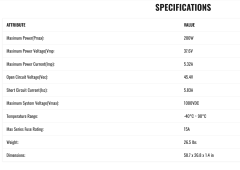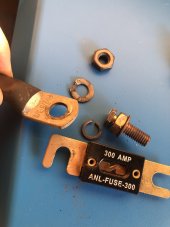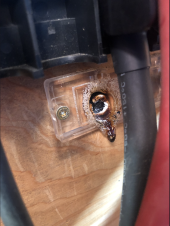jessicadavis
New Member
TLDR; batteries seem to not be charging to their max - need help figuring out the issue
Hey everyone,
New here and wanted to share my setup. I installed it a few months ago but have only recently started living in the space and I've been noticing some weird issues. At a bit of a loss in determining the source problem and I'm hoping someone with a masterful solar gaze will notice something glaringly obvious.
The main issues I've noticed are:
- The power has consistently been going out at night despite using very little energy
- The charge controller has been switching to float (it did this yesterday and my power went out in the middle of last night) when the battery bank clearly isn't full
- The battery monitor has been giving weird readings (saying it's at 0% when there's still power flowing etc). I calibrated the battery monitor to full when the charge controller switched to float, so I'm guessing those issues are connected.
- The solar panels seem to be bringing in way less than they should despite clear sunny skies and the rig isn't parked in shade.
- Generally, feeling like the batteries aren't getting the juice they need and/or there's a miscommunication somewhere along the charging/storing side (the load side has been totally fine except when the batteries are drained)
Full disclosure, I'm completely new to this and recognize I may have chosen an ambitious setup for my first rodeo. Please don't judge my rats nest of cables - the battery bank is obviously very cramped but it's what I had to work with!
Below I've listed the equipment and have some photos attached. Please let me know if I can take more/ provide more information - really want to learn from you all and figure this out
Primary equipment:
4x 200W 24V Rich Solar Panels (series-parallel)
Victron MPPT 150/45 Charge Controller
4x SOK 12v 100Ah batteries (series-parallel for 24V - 200Ah)
Victron Lynx Distributor as busbar
Renogy Battery Monitor
Victron 24V 3000W 70A inverter-charger
24v --> 12v step down converter
furrion 12v distribution panel and blue seas fuse block (for 24v loads)
Hey everyone,
New here and wanted to share my setup. I installed it a few months ago but have only recently started living in the space and I've been noticing some weird issues. At a bit of a loss in determining the source problem and I'm hoping someone with a masterful solar gaze will notice something glaringly obvious.
The main issues I've noticed are:
- The power has consistently been going out at night despite using very little energy
- The charge controller has been switching to float (it did this yesterday and my power went out in the middle of last night) when the battery bank clearly isn't full
- The battery monitor has been giving weird readings (saying it's at 0% when there's still power flowing etc). I calibrated the battery monitor to full when the charge controller switched to float, so I'm guessing those issues are connected.
- The solar panels seem to be bringing in way less than they should despite clear sunny skies and the rig isn't parked in shade.
- Generally, feeling like the batteries aren't getting the juice they need and/or there's a miscommunication somewhere along the charging/storing side (the load side has been totally fine except when the batteries are drained)
Full disclosure, I'm completely new to this and recognize I may have chosen an ambitious setup for my first rodeo. Please don't judge my rats nest of cables - the battery bank is obviously very cramped but it's what I had to work with!
Below I've listed the equipment and have some photos attached. Please let me know if I can take more/ provide more information - really want to learn from you all and figure this out
Primary equipment:
4x 200W 24V Rich Solar Panels (series-parallel)
Victron MPPT 150/45 Charge Controller
4x SOK 12v 100Ah batteries (series-parallel for 24V - 200Ah)
Victron Lynx Distributor as busbar
Renogy Battery Monitor
Victron 24V 3000W 70A inverter-charger
24v --> 12v step down converter
furrion 12v distribution panel and blue seas fuse block (for 24v loads)
Attachments
-
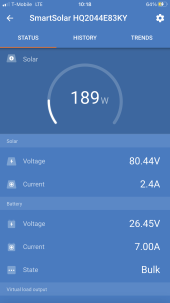 IMG_6422.PNG339.2 KB · Views: 49
IMG_6422.PNG339.2 KB · Views: 49 -
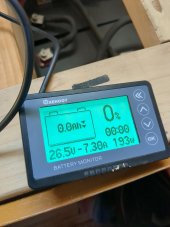 IMG_6430.JPG181.5 KB · Views: 49
IMG_6430.JPG181.5 KB · Views: 49 -
 IMG_6429.JPG299.6 KB · Views: 54
IMG_6429.JPG299.6 KB · Views: 54 -
 IMG_6428.JPG213.6 KB · Views: 52
IMG_6428.JPG213.6 KB · Views: 52 -
 IMG_6427.JPG315.6 KB · Views: 51
IMG_6427.JPG315.6 KB · Views: 51 -
 IMG_6426.JPG212.9 KB · Views: 53
IMG_6426.JPG212.9 KB · Views: 53 -
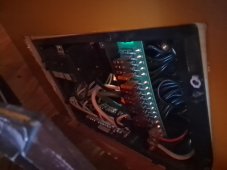 IMG_6425.JPG281.2 KB · Views: 55
IMG_6425.JPG281.2 KB · Views: 55 -
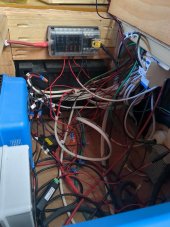 IMG_6424.JPG243.8 KB · Views: 56
IMG_6424.JPG243.8 KB · Views: 56 -
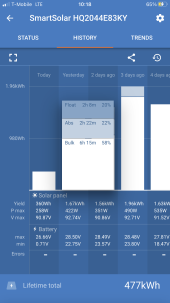 IMG_6423.PNG620.4 KB · Views: 55
IMG_6423.PNG620.4 KB · Views: 55
Last edited:



